Antarctic Transport
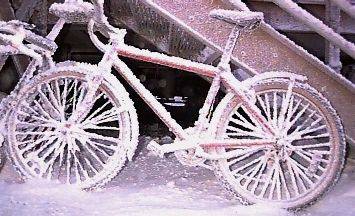 The
good old push bike, used by some people around Scott Base during
the summer months.. We have two of these mountain bikes that
people often push from Scott Base to McMurdo. If you want to know
how well they ride out on the sea ice, you just need to
ask the Green Peace Crew who used them when they had a base in
Antarctica (just up the coast).
The
good old push bike, used by some people around Scott Base during
the summer months.. We have two of these mountain bikes that
people often push from Scott Base to McMurdo. If you want to know
how well they ride out on the sea ice, you just need to
ask the Green Peace Crew who used them when they had a base in
Antarctica (just up the coast).
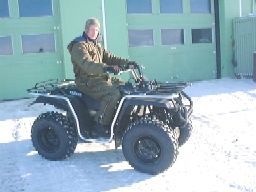 Four wheel drive motor bikes are great for
getting around and about during the summer months. They don't
cost as much as a snow mobile but they also aren't as good in the
cold or deep snow. They do have certain advantage in that they
can be driven on snow, ice or gravel. For lighter towing and
general runabouts they are ideal.
Four wheel drive motor bikes are great for
getting around and about during the summer months. They don't
cost as much as a snow mobile but they also aren't as good in the
cold or deep snow. They do have certain advantage in that they
can be driven on snow, ice or gravel. For lighter towing and
general runabouts they are ideal.
In this photo Jonathan is sitting
outside the garage and about to go around the back of the base to
the storage containers and bring back some small but heavy
equipment.
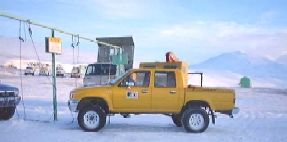 This is one of our Toyotas. They are a four wheel drive vehicle
with a back seat and four doors with the functionality of a ute. This
makes them an excellent all rounder sort of vehicle. They will go through a
surprising amount of snow (until you get stuck) so we use them alot at the beginning
of the season for traveling on the sea ice (when the ice is in really good condition
!!).
This is one of our Toyotas. They are a four wheel drive vehicle
with a back seat and four doors with the functionality of a ute. This
makes them an excellent all rounder sort of vehicle. They will go through a
surprising amount of snow (until you get stuck) so we use them alot at the beginning
of the season for traveling on the sea ice (when the ice is in really good condition
!!).
 In the
winter you've to be vary careful about pre checking your vehicle
before starting it. What you see is a little snow under the
bonnet and if the motor was to try and turn over now it would
snap the fan blade. Pre checking the vehicle includes
unplugging the vehicle, oil and fluid checks, fan blade clear of
snow or ice, radiator warm, tires inflated and any other checks
that may be required, peculiar to that vehicle. For example it
could be anything from a loader to a motor bike or skidoo which
you have to check before starting.
In the
winter you've to be vary careful about pre checking your vehicle
before starting it. What you see is a little snow under the
bonnet and if the motor was to try and turn over now it would
snap the fan blade. Pre checking the vehicle includes
unplugging the vehicle, oil and fluid checks, fan blade clear of
snow or ice, radiator warm, tires inflated and any other checks
that may be required, peculiar to that vehicle. For example it
could be anything from a loader to a motor bike or skidoo which
you have to check before starting.
They come in diesel (JP8) or petrol (MOGAS)
around the 2.5litre size motor. Not big by American standards but
more than adequate for what we need. And we don't go through near
as much fuel as the Americans. You will notice in this photo that
the vehicles are plugged into a hitching rail. All our vehicles
need to be plugged into the mains voltage so that the small
electric heaters we put into the engines and inside the cabs can
keep the vehicles warm while they are not running. If we didn't
do this, the vehicles would be near to impossible to start
and if we did get it started, it would be hard on
the motor as the oil in the motor would become thick and not
lubricate the engine. We use synthetic oils which work better in
the colder climate. We also wrap a special mains powered element
around the battery to keep it warm. All vehicles are factory
standard apart from the heaters we put into them and wider wheels.
It's amazing they do so well.
 These are some of the vehicles that we wont be
using for the winter. We have them parked out of the way and
because we wont be starting them up till next season we don't
have to plug them in to the mains or keep them warm. If we did
want to use them then we would have to put a "HERMY" (a
big blowing heater) under the bonnet (hood) and wait till the
motor had warmed up
These are some of the vehicles that we wont be
using for the winter. We have them parked out of the way and
because we wont be starting them up till next season we don't
have to plug them in to the mains or keep them warm. If we did
want to use them then we would have to put a "HERMY" (a
big blowing heater) under the bonnet (hood) and wait till the
motor had warmed up
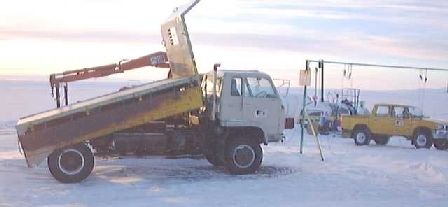 This
is our Isuzu truck. We use it to get large quantities of gear
from one place to another. Mainly, it is used to get gear from
the American base (Mactown) over to our place (Scott Base)
or visa versa.
This
is our Isuzu truck. We use it to get large quantities of gear
from one place to another. Mainly, it is used to get gear from
the American base (Mactown) over to our place (Scott Base)
or visa versa.
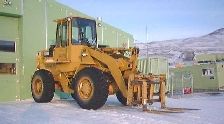 The loader is a
very versatile piece of equipment. It's our main heavy lifting vehicle and with
a bucket on the front it is also used for shifting a bit of snow when the D3
dozer is out of operation. It is also plugged in to the base but you can't
see it as the plug is behind it.
The loader is a
very versatile piece of equipment. It's our main heavy lifting vehicle and with
a bucket on the front it is also used for shifting a bit of snow when the D3
dozer is out of operation. It is also plugged in to the base but you can't
see it as the plug is behind it.
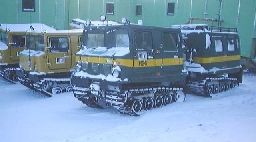 Hagglunds are our all terrain vehicles that we use
for sea ice travel or when the weather and environment is a bit more inclement.
Originally designed and used by the military it is also well suited to the conditions
we live in. They are not cheap though. They cost around $300,000 dollars NZ,
and parts for them are not cheap. They also have a few other good features that
make them excellent. For example, they float. They where made for all conditions
and all terrainincluding amphibious travel.. You will also notice the vehicles
come in two parts. Both front and back tracks are driven, and the steering is
in the middle. It gives them the ability to literally craw over most terrain.
Hagglunds are our all terrain vehicles that we use
for sea ice travel or when the weather and environment is a bit more inclement.
Originally designed and used by the military it is also well suited to the conditions
we live in. They are not cheap though. They cost around $300,000 dollars NZ,
and parts for them are not cheap. They also have a few other good features that
make them excellent. For example, they float. They where made for all conditions
and all terrainincluding amphibious travel.. You will also notice the vehicles
come in two parts. Both front and back tracks are driven, and the steering is
in the middle. It gives them the ability to literally craw over most terrain.
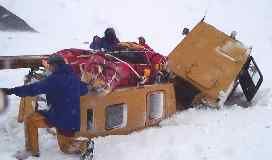

You may ask why anyone
would buy such an expensive vehicle. Vehicles are cheap in
comparison to the loss of life. And lesser vehicles in similar
conditions have killed people. In these two photos one of our
Hagglunds fell through the sea ice. If you were one of the
scientists in the back, you would have been slightly amazed to
notice that the vehicle had stopped, and peoples feet where
visible at eye level. Not many people get to experience the full
effect of an amphibious Hagglunds and so the first time would
have been a bit scary for most. There was no real danger and the
situation was under control.
The Hagglunds stayed in this condition
for about 45 minutes while another one came from Scott Base and
winced it out of the water. A side window was opened up and the
passengers set up a temporary camp (standard practice in case the
weather changes). The baggage on the top of the Hagglunds rear
compartment are all survival bags. Each one is a total survival
kit for two people and they have enough food to last several days.
They are required to be carried if you go outside the bounds of
Scott Base or McMurdo. These pictures were also
shown in the local papers back in NZ so hopefully no one will
make a fuss about me showing them here. As I said, vehicles
dropping through the sea ice doesn't happen very often, but when
it does, you want to be in a vehicle that is capableof saving
your life in the situation, so that's what we use !!.
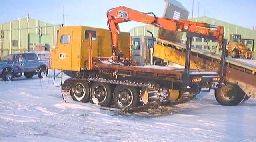 This is a Nodwell tracked
vehicle that has been modified with the addition of a small crane. It can't
carry much but it is handy for small jobs.
This is a Nodwell tracked
vehicle that has been modified with the addition of a small crane. It can't
carry much but it is handy for small jobs.
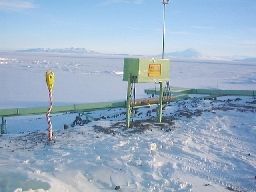 How would you like this as a waterfront view when
you park you vehicle? The box contains transformers to
convert our New Zealand 230 volt mains to 110 volts so that the
Americans can plug their vehicles into it. Just another hitching
rail, in other words. Beside it is the parking meter, but
strangely there isn't much money in it. In front of the green
pipes is sea ice that is only about 3 inches thick at the moment
(later, during the winter it will get to about 1.8 meters thick
and built up with pressure ridges ). Behind that you can see
Black Island to the left, and to the right, I think, is Mount
Discovery (whatever, Ill find out and update this later). Nice
view !!
How would you like this as a waterfront view when
you park you vehicle? The box contains transformers to
convert our New Zealand 230 volt mains to 110 volts so that the
Americans can plug their vehicles into it. Just another hitching
rail, in other words. Beside it is the parking meter, but
strangely there isn't much money in it. In front of the green
pipes is sea ice that is only about 3 inches thick at the moment
(later, during the winter it will get to about 1.8 meters thick
and built up with pressure ridges ). Behind that you can see
Black Island to the left, and to the right, I think, is Mount
Discovery (whatever, Ill find out and update this later). Nice
view !!
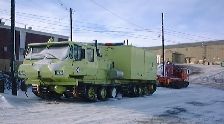 The American all terrain fire truck. Built very similar
to the Hagglunds, although after talking to the fire crew,they are not nearly
as good. These things don't travel on soft snow very well. They have a tendency
to be to heavy and get stuck. They are also not amphibious. I hope that if there
is ever a plane crash it isn't to far from the runway.
The American all terrain fire truck. Built very similar
to the Hagglunds, although after talking to the fire crew,they are not nearly
as good. These things don't travel on soft snow very well. They have a tendency
to be to heavy and get stuck. They are also not amphibious. I hope that if there
is ever a plane crash it isn't to far from the runway.
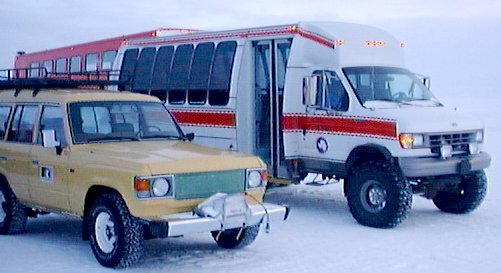 These are some of the small buses that the
Americans use for getting around the place. Transporting people
from McMurdo to the air fields is their main priority. On the left hand
side is the smaller Scott Base passenger carrier. It's just a
Toyota Land cruiser but it does the job OK.
These are some of the small buses that the
Americans use for getting around the place. Transporting people
from McMurdo to the air fields is their main priority. On the left hand
side is the smaller Scott Base passenger carrier. It's just a
Toyota Land cruiser but it does the job OK.
 This is a stretched D8 low ground pressure bull
dozer. They were specially made by the manufacturer for the
Americans down in Antarctica. They were built in 1957, I
think, and there were only 15 ever made. This is the only
place you will find them in the world. The idea is that with the
long tracks and reduced pressure per square foot then there is
less chance of them sinking too deep into snow or
falling through the ice.
This is a stretched D8 low ground pressure bull
dozer. They were specially made by the manufacturer for the
Americans down in Antarctica. They were built in 1957, I
think, and there were only 15 ever made. This is the only
place you will find them in the world. The idea is that with the
long tracks and reduced pressure per square foot then there is
less chance of them sinking too deep into snow or
falling through the ice.
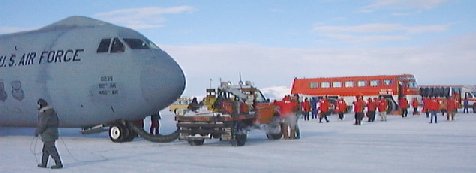 Here we have people get getting off the Star
Lifter, many of them new and fresh to the ways of Antarctica.
People who have been here a while call the new people "FINGYS",
Fabulous New Guys. There is also a more derogatory meaning for
the same term but this is my home page and I can say what I want.
(More about aircraft in the aircraft section.)Notice how there hot air hose jammed up and under
the landing gear of the plane. Its to stop the landing gear from
freezing while its sits on the ice.
Here we have people get getting off the Star
Lifter, many of them new and fresh to the ways of Antarctica.
People who have been here a while call the new people "FINGYS",
Fabulous New Guys. There is also a more derogatory meaning for
the same term but this is my home page and I can say what I want.
(More about aircraft in the aircraft section.)Notice how there hot air hose jammed up and under
the landing gear of the plane. Its to stop the landing gear from
freezing while its sits on the ice.
.
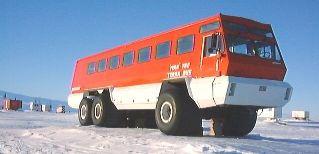 This
is the Terra bus as seen in the kids Quest page. As you can see,
it's up on blocks and winterized at the moment . Without the
blocks underneath the tires could become permanently deformed
with flat spots during the extreme cold of the winter, especially
if theywere to go flat. This vehicle is used to transport large
numbers of people to and from the air fields. On the side it has
been nicknamed IVAN THE TERRA BUS.
This
is the Terra bus as seen in the kids Quest page. As you can see,
it's up on blocks and winterized at the moment . Without the
blocks underneath the tires could become permanently deformed
with flat spots during the extreme cold of the winter, especially
if theywere to go flat. This vehicle is used to transport large
numbers of people to and from the air fields. On the side it has
been nicknamed IVAN THE TERRA BUS.
There are some more photos that I want
to put into this, but I will have to do that later. Some is
better than none.
We have other specialized vehicles
allocated to the Scott Base Antarctic NZ program, but these have
been seconded to a remote project called "Cape Robert's,"
where they are drilling for ground core samples farther
north. The vehicles are staying with the project until the
drilling is finished, which will be another few years.
Skidoos
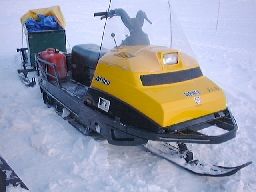 They
were reputedly going to be named ski dogs, but apparently
the printers made a mistake and called them what they are known
as today. These particular machines are real workhorses, and even
though they can get up to 70 km per hour, its too dangerous
and 30 Km per is recommended. They run on two stroke fuel and if
they don't work with the key start switch you can use the pull
start to get them working.
They
were reputedly going to be named ski dogs, but apparently
the printers made a mistake and called them what they are known
as today. These particular machines are real workhorses, and even
though they can get up to 70 km per hour, its too dangerous
and 30 Km per is recommended. They run on two stroke fuel and if
they don't work with the key start switch you can use the pull
start to get them working.
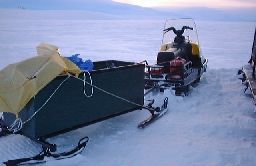 Even with all the safety equipment and other
stuff we carry, it is often practical to use a sled. In this case,
I used a bombardier sled (I think that's what its called)
out to the "A frame" hut last time I went out. There
are many different types of sleds we use, big, small, etc. Each
type has a purpose.
Even with all the safety equipment and other
stuff we carry, it is often practical to use a sled. In this case,
I used a bombardier sled (I think that's what its called)
out to the "A frame" hut last time I went out. There
are many different types of sleds we use, big, small, etc. Each
type has a purpose.
Photos taken at about 10 am Sunday 12-4-97,
as I was packing up to come home after a night of blissful
isolation almost at the end of the world.
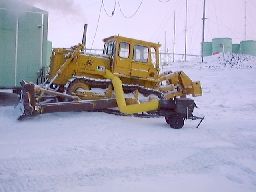

This is the Scott Base D8
and the to Scott base Troop Carriers. Chris, the mechanic,
is warming them up before they can be used . He had the
HERMY (the heater with the hose sticking out) warming up the
engine 45 minutes before he started the D8. He then left the D8
running for a while before removing the Herman Nelson (Hermy)
heater just to be sure it was warm enough. You can also see that
Chris had to put batteries back into the vehicles after they had
spent a winter without being used.
www.geocities.com/coolrunnernz/
9-3-01
Edited by Shirley Baston Fred - [email protected]
- ICQQ # 15167279
 The
good old push bike, used by some people around Scott Base during
the summer months.. We have two of these mountain bikes that
people often push from Scott Base to McMurdo. If you want to know
how well they ride out on the sea ice, you just need to
ask the Green Peace Crew who used them when they had a base in
Antarctica (just up the coast).
The
good old push bike, used by some people around Scott Base during
the summer months.. We have two of these mountain bikes that
people often push from Scott Base to McMurdo. If you want to know
how well they ride out on the sea ice, you just need to
ask the Green Peace Crew who used them when they had a base in
Antarctica (just up the coast).  Four wheel drive motor bikes are great for
getting around and about during the summer months. They don't
cost as much as a snow mobile but they also aren't as good in the
cold or deep snow. They do have certain advantage in that they
can be driven on snow, ice or gravel. For lighter towing and
general runabouts they are ideal.
Four wheel drive motor bikes are great for
getting around and about during the summer months. They don't
cost as much as a snow mobile but they also aren't as good in the
cold or deep snow. They do have certain advantage in that they
can be driven on snow, ice or gravel. For lighter towing and
general runabouts they are ideal.  This is one of our Toyotas. They are a four wheel drive vehicle
with a back seat and four doors with the functionality of a ute. This
makes them an excellent all rounder sort of vehicle. They will go through a
surprising amount of snow (until you get stuck) so we use them alot at the beginning
of the season for traveling on the sea ice (when the ice is in really good condition
!!).
This is one of our Toyotas. They are a four wheel drive vehicle
with a back seat and four doors with the functionality of a ute. This
makes them an excellent all rounder sort of vehicle. They will go through a
surprising amount of snow (until you get stuck) so we use them alot at the beginning
of the season for traveling on the sea ice (when the ice is in really good condition
!!).  In the
winter you've to be vary careful about pre checking your vehicle
before starting it. What you see is a little snow under the
bonnet and if the motor was to try and turn over now it would
snap the fan blade. Pre checking the vehicle includes
unplugging the vehicle, oil and fluid checks, fan blade clear of
snow or ice, radiator warm, tires inflated and any other checks
that may be required, peculiar to that vehicle. For example it
could be anything from a loader to a motor bike or skidoo which
you have to check before starting.
In the
winter you've to be vary careful about pre checking your vehicle
before starting it. What you see is a little snow under the
bonnet and if the motor was to try and turn over now it would
snap the fan blade. Pre checking the vehicle includes
unplugging the vehicle, oil and fluid checks, fan blade clear of
snow or ice, radiator warm, tires inflated and any other checks
that may be required, peculiar to that vehicle. For example it
could be anything from a loader to a motor bike or skidoo which
you have to check before starting.  These are some of the vehicles that we wont be
using for the winter. We have them parked out of the way and
because we wont be starting them up till next season we don't
have to plug them in to the mains or keep them warm. If we did
want to use them then we would have to put a "HERMY" (a
big blowing heater) under the bonnet (hood) and wait till the
motor had warmed up
These are some of the vehicles that we wont be
using for the winter. We have them parked out of the way and
because we wont be starting them up till next season we don't
have to plug them in to the mains or keep them warm. If we did
want to use them then we would have to put a "HERMY" (a
big blowing heater) under the bonnet (hood) and wait till the
motor had warmed up  This
is our Isuzu truck. We use it to get large quantities of gear
from one place to another. Mainly, it is used to get gear from
the American base (Mactown) over to our place (Scott Base)
or visa versa.
This
is our Isuzu truck. We use it to get large quantities of gear
from one place to another. Mainly, it is used to get gear from
the American base (Mactown) over to our place (Scott Base)
or visa versa. 
 Hagglunds are our all terrain vehicles that we use
for sea ice travel or when the weather and environment is a bit more inclement.
Originally designed and used by the military it is also well suited to the conditions
we live in. They are not cheap though. They cost around $300,000 dollars NZ,
and parts for them are not cheap. They also have a few other good features that
make them excellent. For example, they float. They where made for all conditions
and all terrainincluding amphibious travel.. You will also notice the vehicles
come in two parts. Both front and back tracks are driven, and the steering is
in the middle. It gives them the ability to literally craw over most terrain.
Hagglunds are our all terrain vehicles that we use
for sea ice travel or when the weather and environment is a bit more inclement.
Originally designed and used by the military it is also well suited to the conditions
we live in. They are not cheap though. They cost around $300,000 dollars NZ,
and parts for them are not cheap. They also have a few other good features that
make them excellent. For example, they float. They where made for all conditions
and all terrainincluding amphibious travel.. You will also notice the vehicles
come in two parts. Both front and back tracks are driven, and the steering is
in the middle. It gives them the ability to literally craw over most terrain.


 This is a Nodwell tracked
vehicle that has been modified with the addition of a small crane. It can't
carry much but it is handy for small jobs.
This is a Nodwell tracked
vehicle that has been modified with the addition of a small crane. It can't
carry much but it is handy for small jobs.  How would you like this as a waterfront view when
you park you vehicle? The box contains transformers to
convert our New Zealand 230 volt mains to 110 volts so that the
Americans can plug their vehicles into it. Just another hitching
rail, in other words. Beside it is the parking meter, but
strangely there isn't much money in it. In front of the green
pipes is sea ice that is only about 3 inches thick at the moment
(later, during the winter it will get to about 1.8 meters thick
and built up with pressure ridges ). Behind that you can see
Black Island to the left, and to the right, I think, is Mount
Discovery (whatever, Ill find out and update this later). Nice
view !!
How would you like this as a waterfront view when
you park you vehicle? The box contains transformers to
convert our New Zealand 230 volt mains to 110 volts so that the
Americans can plug their vehicles into it. Just another hitching
rail, in other words. Beside it is the parking meter, but
strangely there isn't much money in it. In front of the green
pipes is sea ice that is only about 3 inches thick at the moment
(later, during the winter it will get to about 1.8 meters thick
and built up with pressure ridges ). Behind that you can see
Black Island to the left, and to the right, I think, is Mount
Discovery (whatever, Ill find out and update this later). Nice
view !!  The American all terrain fire truck. Built very similar
to the Hagglunds, although after talking to the fire crew,they are not nearly
as good. These things don't travel on soft snow very well. They have a tendency
to be to heavy and get stuck. They are also not amphibious. I hope that if there
is ever a plane crash it isn't to far from the runway.
The American all terrain fire truck. Built very similar
to the Hagglunds, although after talking to the fire crew,they are not nearly
as good. These things don't travel on soft snow very well. They have a tendency
to be to heavy and get stuck. They are also not amphibious. I hope that if there
is ever a plane crash it isn't to far from the runway.  These are some of the small buses that the
Americans use for getting around the place. Transporting people
from McMurdo to the air fields is their main priority. On the left hand
side is the smaller Scott Base passenger carrier. It's just a
Toyota Land cruiser but it does the job OK.
These are some of the small buses that the
Americans use for getting around the place. Transporting people
from McMurdo to the air fields is their main priority. On the left hand
side is the smaller Scott Base passenger carrier. It's just a
Toyota Land cruiser but it does the job OK.  This is a stretched D8 low ground pressure bull
dozer. They were specially made by the manufacturer for the
Americans down in Antarctica. They were built in 1957, I
think, and there were only 15 ever made. This is the only
place you will find them in the world. The idea is that with the
long tracks and reduced pressure per square foot then there is
less chance of them sinking too deep into snow or
falling through the ice.
This is a stretched D8 low ground pressure bull
dozer. They were specially made by the manufacturer for the
Americans down in Antarctica. They were built in 1957, I
think, and there were only 15 ever made. This is the only
place you will find them in the world. The idea is that with the
long tracks and reduced pressure per square foot then there is
less chance of them sinking too deep into snow or
falling through the ice.  Here we have people get getting off the Star
Lifter, many of them new and fresh to the ways of Antarctica.
People who have been here a while call the new people "FINGYS",
Fabulous New Guys. There is also a more derogatory meaning for
the same term but this is my home page and I can say what I want.
(More about aircraft in the aircraft section.)Notice how there hot air hose jammed up and under
the landing gear of the plane. Its to stop the landing gear from
freezing while its sits on the ice.
Here we have people get getting off the Star
Lifter, many of them new and fresh to the ways of Antarctica.
People who have been here a while call the new people "FINGYS",
Fabulous New Guys. There is also a more derogatory meaning for
the same term but this is my home page and I can say what I want.
(More about aircraft in the aircraft section.)Notice how there hot air hose jammed up and under
the landing gear of the plane. Its to stop the landing gear from
freezing while its sits on the ice.  This
is the Terra bus as seen in the kids Quest page. As you can see,
it's up on blocks and winterized at the moment . Without the
blocks underneath the tires could become permanently deformed
with flat spots during the extreme cold of the winter, especially
if theywere to go flat. This vehicle is used to transport large
numbers of people to and from the air fields. On the side it has
been nicknamed IVAN THE TERRA BUS.
This
is the Terra bus as seen in the kids Quest page. As you can see,
it's up on blocks and winterized at the moment . Without the
blocks underneath the tires could become permanently deformed
with flat spots during the extreme cold of the winter, especially
if theywere to go flat. This vehicle is used to transport large
numbers of people to and from the air fields. On the side it has
been nicknamed IVAN THE TERRA BUS.  They
were reputedly going to be named ski dogs, but apparently
the printers made a mistake and called them what they are known
as today. These particular machines are real workhorses, and even
though they can get up to 70 km per hour, its too dangerous
and 30 Km per is recommended. They run on two stroke fuel and if
they don't work with the key start switch you can use the pull
start to get them working.
They
were reputedly going to be named ski dogs, but apparently
the printers made a mistake and called them what they are known
as today. These particular machines are real workhorses, and even
though they can get up to 70 km per hour, its too dangerous
and 30 Km per is recommended. They run on two stroke fuel and if
they don't work with the key start switch you can use the pull
start to get them working.  Even with all the safety equipment and other
stuff we carry, it is often practical to use a sled. In this case,
I used a bombardier sled (I think that's what its called)
out to the "A frame" hut last time I went out. There
are many different types of sleds we use, big, small, etc. Each
type has a purpose.
Even with all the safety equipment and other
stuff we carry, it is often practical to use a sled. In this case,
I used a bombardier sled (I think that's what its called)
out to the "A frame" hut last time I went out. There
are many different types of sleds we use, big, small, etc. Each
type has a purpose. 
